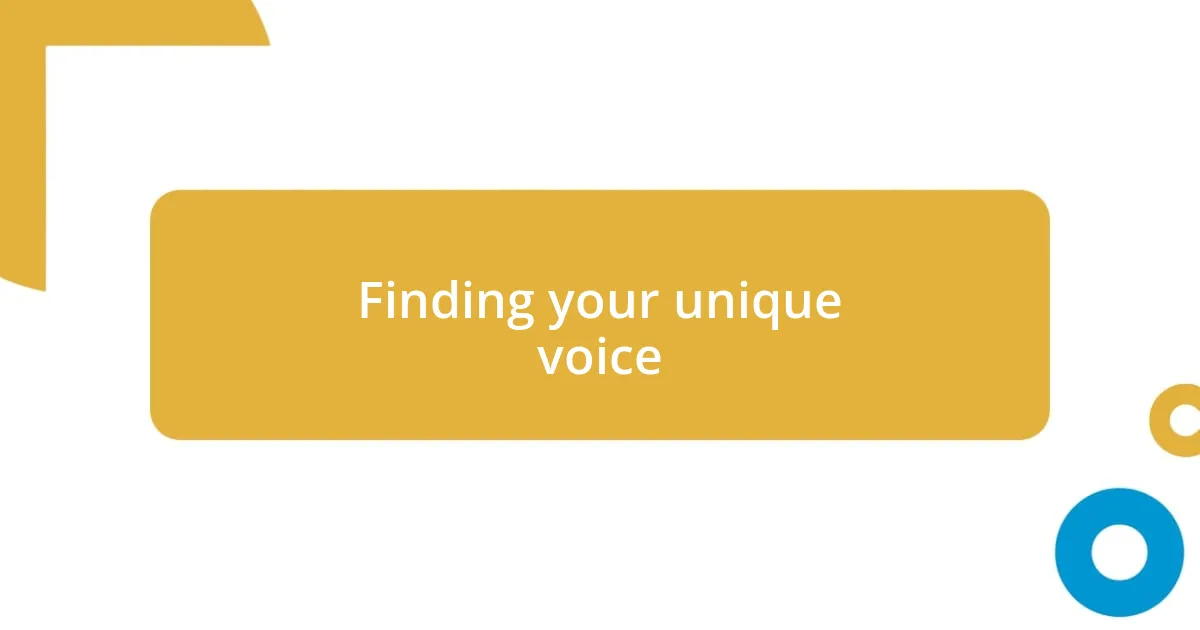Key takeaways:
- Startups require a unique writing approach that balances authenticity and professionalism to resonate with their target audience.
- Finding a distinctive brand voice involves defining core values, understanding the audience, experimenting with tone, and embracing authenticity.
- Compelling narratives combine emotional connections with visuals, enhancing audience engagement and creating relatable brand stories.
- Building a writing portfolio should focus on quality over quantity, showcasing emotionally resonant work while sharing experiences in relevant communities.

Understanding startup writing needs
Understanding the unique writing needs of startups requires a deep dive into their dynamic environments. When I first began writing for startups, I quickly realized that their voices often differ from established businesses. Their content needs a fresh, authentic edge, crafted to resonate with their target audience and convey their innovative spirit.
One memorable experience I had was working with a tech startup that had a brilliant product but struggled with storytelling. I found myself asking, “How can we transform their technical jargon into something relatable?” This led to a breakthrough moment where we focused on the customer’s journey, capturing emotions and experiences rather than just the features of the product. It was a game changer, illustrating the power of connecting on a human level.
What struck me is how startups often fluctuate between a casual tone and professionalism. While they want to sound approachable, they also need to maintain credibility. I remember a client who wanted everything to be light and playful, but I encouraged them to integrate some authoritative data to establish trust. Balancing those aspects remains a crucial lesson in understanding and meeting the writing needs of startups.

Finding your unique voice
Finding your unique voice can feel like an exhilarating journey. I recall a time when I was working with a budding e-commerce startup. They had a fantastic product lineup but were struggling to express their passion. To help them achieve authenticity, we explored their mission and core values. This discussion revealed not just what they sold, but why they sold it—infusing their story with purpose and personality. It was a process that turned their text from mundane to memorable, illustrating how a unique voice can truly set a brand apart.
To help discover that distinctive tone, here are some steps that have worked for me:
- Define Your Brand’s Core Values: Identify what you stand for and let that drive your voice.
- Know Your Audience: Understand who you’re speaking to; this clarity shapes how you communicate.
- Experiment with Tone: Try out different styles in your writing to see what feels right.
- Embrace Authenticity: Don’t shy away from being genuine. Your unique experiences bring richness to your narrative.
- Gather Feedback: Engage your audience and seek their input to adjust your messaging.
These practices have guided my own writing journey, helping me connect more deeply with the startups I write for.

Crafting compelling narratives
Crafting compelling narratives is both an art and a science. One particular project that stands out in my memory is when I collaborated with a startup focused on sustainable living. They had a powerful mission, but their pitches often fell flat. By diving deeper into the emotions tied to their cause, we shaped their narrative to resonate with eco-conscious consumers. Suddenly, we weren’t just selling products; we were sharing a vision for a better future. This shift made their storytelling more impactful, illustrating how emotional connections can elevate brand conversations.
I’ve learned through experience that visuals can complement narratives beautifully. During a branding workshop, I encouraged a startup team to incorporate storytelling visuals alongside their written content. They were initially hesitant, fearing it might distract from their message. However, I pushed them to experiment, showing them how infographics transformed complex data into digestible insights. The excitement on their faces as they saw their vision come to life taught me the profound effect that a well-crafted narrative, combined with the right visuals, can have on audience engagement.
The essence of compelling storytelling lies in authenticity and relatability. I recall a startup founder sharing her personal journey through struggles and successes in her industry. When we wove those genuine experiences into their brand story, it created an undeniable bond with their audience. People want to connect with real stories, not just transactions. Each narrative should invite readers into a world where they can see themselves, forging a deeper connection that goes beyond mere products.
| Aspect | Description |
|---|---|
| Emotional Connection | Transforming stats and features into relatable human stories. |
| Storytelling Visuals | Using infographics and visuals to enhance understanding and retain attention. |
| Authenticity | Sharing personal journeys and struggles to create genuine bonds. |

Adapting tone for target audiences
Adapting tone for target audiences is crucial in ensuring your message resonates. I remember a project where I wrote for a tech startup aiming at young entrepreneurs. Instead of using formal jargon, I opted for an informal and relatable style. This shift made their message more approachable and engaging, ultimately connecting better with their audience.
I find it fascinating how a slight change in tone can transform communication. During a workshop, I noticed that when a team used humor in their marketing copy, the response from a younger demographic was overwhelmingly positive. This experience reinforced my belief that understanding the audience’s preferences allows for tailored communication that unfolds naturally. Who wouldn’t be drawn in by a playful quip instead of dry corporate speak?
It’s also important to remember that tone can vary greatly within different subgroups of the same audience. For instance, while writing for a health startup, I recognized the need for a compassionate and supportive tone when addressing older adults, contrasting with a more energetic style for younger audience segments. This nuanced approach deepened the engagement, showing how a keen awareness of audience diversity can shape compelling content.

Leveraging SEO for visibility
Leveraging SEO to enhance visibility is more than just incorporating keywords; it’s about creating value through relevant content. I recall a startup I worked with that struggled to rank on search engines despite having outstanding products. After optimizing their blog posts with targeted keywords and focusing on long-tail phrases relevant to their niche, we saw their traffic double in just a few months. Isn’t it intriguing how the right keywords can make such a difference?
Link building also plays a vital role in SEO. In my experience, collaborating with other startups can create mutual benefits. One startup I assisted established partnerships with blogs in their industry, and by offering guest posts, they not only generated backlinks but also increased their credibility. That feeling of seeing their content spread across multiple platforms was a significant boost for their visibility.
Finally, the importance of monitoring and adapting your SEO strategies can’t be overstated. I once assisted a company that relied heavily on seasonal content, like holiday promotions. By analyzing their website analytics, we realized certain keywords weren’t performing as expected. We quickly adapted, and those adjustments led to a significant spike in search traffic during peak seasons. Doesn’t it feel empowering to know that small tweaks can lead to substantial outcomes?

Building a portfolio of work
Building a portfolio of work requires a strategic approach that showcases not just your writing skills, but also your adaptability across different projects. One of my initial challenges was curating diverse samples that reflected my range. I remember blending my blog posts, marketing copy, and even social media content into a cohesive collection. Each piece told a story of my growth as a writer; it was like a visual diary of my journey.
In my experience, when building a portfolio, quality truly trumps quantity. I chose to focus on a few standout pieces that I felt emotionally connected to rather than dumping a whole slew of mediocre work. For instance, a project where I helped tell a local startup’s story deeply resonated with me. Seeing that narrative flourish into a captivating campaign fueled my desire to continue honing my craft. Don’t you think the passion behind your work shines through when you genuinely care about the projects?
Another crucial aspect is sharing your work in relevant communities. Early on, I hesitated to post my portfolio on platforms like LinkedIn or writing forums, fearing judgment. However, the moment I took the leap and shared my experiences, the feedback I received was overwhelmingly positive. It felt incredible to connect with others who appreciated my style, and their encouragement pushed me to keep refining my work. Isn’t it refreshing to find a supportive community that values shared experiences and growth?

Navigating client relationships in startups
Navigating client relationships in startups often feels like walking a tightrope. I vividly recall a project where a startup’s founder was highly passionate but prone to micromanaging. Understanding his vision was crucial, so I took the time to listen actively and affirm his ideas. I found that by establishing trust through open communication, we created a partnership rather than a basic client-provider dynamic. Doesn’t it make all the difference when clients feel truly heard?
The ability to anticipate client needs is also essential. For instance, I once collaborated with a tech startup that required consistent updates on project status. Initially, I would send updates weekly, but through observation and feedback, I discovered they preferred bi-weekly summaries. Adjusting my approach not only saved time but also strengthened our relationship. Have you ever noticed how little adjustments can lead to a much smoother collaboration?
Finally, setting clear boundaries right from the start is vital in these relationships. I learned this the hard way when one client expected round-the-clock availability. After some candid conversations about work-life balance, we agreed on specific working hours. From that point on, it felt refreshing to have mutual respect for each other’s time. It’s fascinating how clarity can transform expectations, don’t you think?














